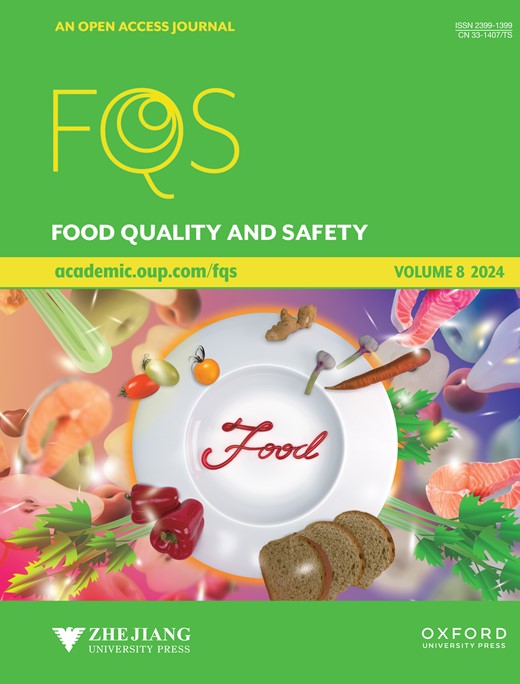Effects of different dietary lipid levels on physiological metabolism and odor quality of hepatopancreas in adult female Chinese mitten crab (Eriocheir sinensis)
IF 3
3区 农林科学
Q2 FOOD SCIENCE & TECHNOLOGY
引用次数: 0
Abstract
This study aimed to investigate the impact of different dietary lipid levels on the physiological metabolism and odor quality of adult female Eriocheir sinensis during the fattening phase. Five dietary schemes, each containing different total lipid levels (4%, 7%, 10%, 13%, and 16%) were administered over a 60-day fattening period for adult female crab (approximately 50 g, n = 60). Dietary lipids had no significant effect on growth performance and hepatopancreas index (P < 0.05). The carotenoid content showed an increasing and then decreasing trend, with a significant increase to 1312.51 mg/kg (P < 0.05) at 7% lipid content of the diet. In contrast, a diet with a 13% lipid level led to a significant increase in total unsaturated fatty acids (115.3 mg/g, P < 0.05), which maximized the contents of major fatty acids (oleic, linoleic, and linolenic, among others), and present a fluctuating trend. A diet with higher lipid levels (16%) inhibited fatty acid accumulation. Moreover, a 13% dietary lipid level enhanced characteristic aroma compounds (e.g., nonanal, octanal, hexanal, 3-methylbutanal, 2-heptanone, among others) in E. sinensis cooked hepatopancreas. Through an orthogonal partial least squares discriminant analysis (OPLS-DA) model, it becomes evident that lipids and carotenoids together promote aroma formation in hepatopancreas. Based on the current findings, the optimal dietary lipid level for enhancing the odor quality of hepatopancreas in adult female E. sinensis during the fattening phase was 13%. This study provides more precise options for the high-quality cultivation of E. sinensis.不同膳食脂质水平对中华绒螯蟹成年雌蟹肝胰腺生理代谢和气味质量的影响
本研究旨在探讨不同日粮脂质水平对中华绒螯蟹育肥期雌性成蟹生理代谢和气味品质的影响。在为期 60 天的育肥期中,对成年雌蟹(约 50 克,n = 60)采用五种日粮方案,每种方案含有不同的总脂质水平(4%、7%、10%、13% 和 16%)。膳食脂质对生长性能和肝胰腺指数没有显著影响(P < 0.05)。类胡萝卜素含量呈先升后降的趋势,当日粮脂质含量为 7% 时,类胡萝卜素含量显著增加至 1312.51 mg/kg(P < 0.05)。相反,脂质含量为 13% 的日粮导致不饱和脂肪酸总量显著增加(115.3 毫克/克,P < 0.05),使主要脂肪酸(油酸、亚油酸和亚麻酸等)的含量最大化,并呈现波动趋势。脂质含量较高的日粮(16%)抑制了脂肪酸的积累。此外,13% 的日粮脂质水平会增加中华鳖熟肝胰腺中的特征香气化合物(如壬醛、辛醛、己醛、3-甲基丁醛、2-庚酮等)。通过正交偏最小二乘判别分析(OPLS-DA)模型,可以明显看出脂类和类胡萝卜素共同促进了肝胰脏中香气的形成。根据目前的研究结果,在育肥阶段,提高成年雌性中华绒山羊肝胰腺气味质量的最佳日粮脂质水平为 13%。这项研究为高质量养殖中华鳖提供了更精确的选择。
本文章由计算机程序翻译,如有差异,请以英文原文为准。
求助全文
约1分钟内获得全文
求助全文
来源期刊

Food Quality and Safety
FOOD SCIENCE & TECHNOLOGY-
CiteScore
7.20
自引率
1.80%
发文量
31
审稿时长
5 weeks
期刊介绍:
Food quality and safety are the main targets of investigation in food production. Therefore, reliable paths to detect, identify, quantify, characterize and monitor quality and safety issues occurring in food are of great interest.
Food Quality and Safety is an open access, international, peer-reviewed journal providing a platform to highlight emerging and innovative science and technology in the agro-food field, publishing up-to-date research in the areas of food quality and safety, food nutrition and human health. It promotes food and health equity which will consequently promote public health and combat diseases.
The journal is an effective channel of communication between food scientists, nutritionists, public health professionals, food producers, food marketers, policy makers, governmental and non-governmental agencies, and others concerned with the food safety, nutrition and public health dimensions.
The journal accepts original research articles, review papers, technical reports, case studies, conference reports, and book reviews articles.
 求助内容:
求助内容: 应助结果提醒方式:
应助结果提醒方式:


